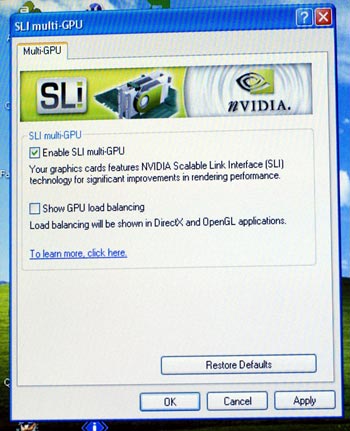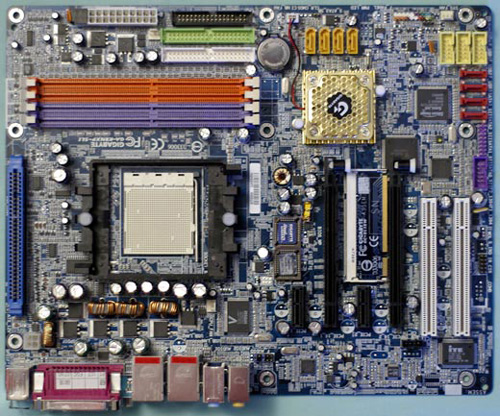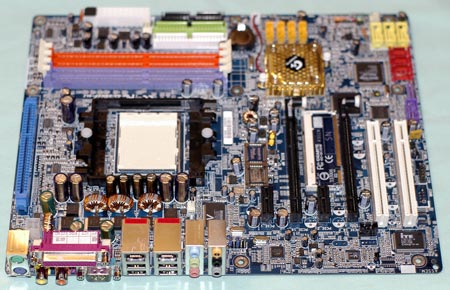FIRST LOOK: Gigabyte K8NXP-SLI
by Wesley Fink on November 24, 2004 9:00 PM EST- Posted in
- Motherboards
Features: Gigabyte K8NXP-SLI
Consider the K8NXP-SLI as an K8NXP-9 with SLI. Gigabyte has added all the BIOS options promised for the production boards and then some. Particularly interesting are the 0.5MHz increments available for very fine tweaking in the most used 200-270 CPU clock range, with 1MHz increments to the top speed of 400. The only item that proved too large a challenge for the production board was a wider range of memory voltages. Gigabyte states that future revisions of their nForce4 boards may see an increased memory voltage range, but that a boost in vDIMM options now would have required a board redesign. Gigabyte has tweaked the available vDIMM options to provide an adjustment range from 2.6V to 2.8V. As you will see in our overclocking tests, this had little impact on overclocking abilities, although a broader range is preferred and would have likely facilitated higher memory overclocking.| Gigabyte K8NXP-SLI Specifications | |
| CPU Interface | Socket 939 Athlon 64 |
| Chipset | nVidia nForce 4 Ultra (Single-Chip) |
| Bus Speeds | 200 to 400 200 - 270 in 0.5MHz increments 271 - 400 in 1MHz increments |
| PCI Express Speeds | 100 - 150 fixed in 1MHz increments |
| Core Voltage | 0.8V to 1.75V in 0.025V increments |
| CPU Clock Multiplier | 4x-20x in 1X increments |
| HyperTransport Frequency | 1000MHz (1GHz) |
| HyperTransport Multiplier | 1X, 2X, 3x, 4X, 5x, Auto |
| DRAM Voltage | 2.6V to 2.8V in 0.1V increments (Normal, +0.1, +0.2) |
| PCIe Voltage | Normal, + 0.1v, +0.2v, +0.3v |
| HyperTransport Voltage | Normal, + 0.1V, +0.2V, +0.3V |
| Robust Graphics Booster | Auto, Fast, Turbo |
| Memory Slots | Four 184-pin DDR DIMM Slots Dual-Channel Configuration Regular Unbuffered Memory to 4GB Total |
| Expansion Slots | 2 x8/x16 (Programmable) PCIe Slot 2 x1 PCIe Slots 2 PCI Slots |
| Onboard SATA/SATA RAID | 8 SATA Drive Total 4 SATA 300 Drives by nForce4 (RAID 0, 1, 0+1, JBOD) Can be combined with IDE drives in RAID 4 SATA 150 Drives by Sil3114CT176 (RAID 0, 1, 0+1, JBOD) |
| Onboard IDE/IDE RAID | Two Standard ATA133/100/66 (4 drives) Drives may be as IDE RAID or combined with nF4 SATA drives in a RAID Array |
| Onboard USB 2.0/IEEE-1394 | 10 USB 2.0 ports supported by nForce4 2 Firewire High-Speed 1394B by TI 46A9C3W |
| Onboard LAN | Dual Gigabit LAN On-chip Gigabit LAN by nF4/Cicada 8201 PHY PCI Express Gigabit LAN by Marvel 88E8053 |
| Wireless LAN | PCI 802.11b/g Wireless LAN Card Included |
| Onboard Audio | AC '97 2.3 8-Channel by Realtek ALC850 |
| BIOS Revision | Award K8NXP-SLI F2c 11/22/2004 |
The updated Gigabyte BIOS for the K8NXP-9/K8NXP-SLI family provides a very wide and useful range of adjustments for other features. Continuing with the Gigabyte custom in recent designs, Advanced Chipset Features (and Memory Timings) can only be seen when you press CTRL+F1 while in the BIOS. HyperTransport adjustments are also provided in the hidden Advanced Chipset Features menu.
There are no BIOS options for adjusting or controlling SLI. This is handled in the nForce4 platform drivers and the nVidia graphics drivers.
A new properties section appears in the Advanced properties GeForce tab for boards supporting SLI. This tells you that SLI is possible by installing a second video card. When the board between the PCIe video slots is turned to the SLI position and a second video card is installed with an SLI connector or bridge on top, new messages pop up telling you how to enable SLI.

The process is very easy, but don't assume that anything is wrong if you don't see SLI on the first boot. The first boot identified the video card. After we rebooted, the SLI was recognized and pop-ups led us though enabling SLI. The only boards currently working in SLI are the nVidia 6600GT, 6800GT, and 6800 Ultra. nVidia has stated that future 6800 video cards will also support SLI.
The Gigabyte K8NXP-SLI, like the sister K8NXP-9, was designed as a top-of-the-line nForce4 motherboard. As the flagship model, it sports all the top Gigabyte features.

The SLI version also supports the trademark DPS daughter to increase power reserves and stability by increasing the board to 6-phase power. You can see the DPS slot to the left of the CPU. You will also see dual BIOS chips to the left of the main PCIe video slot. This Gigabyte feature provides back-up BIOS in the event of a bad flash or unstable BIOS setting. The K8NXP-SLI can boot from the good backup BIOS if problems arise with the main BIOS.

Continuing the theme of "more than you might expect", Gigabyte provides eight SATA ports. Four ports are 3Gb/s ports provided by the nForce4 chip, and the other are four 1.5Gb/s ports driven by the PCI bus.
In the nForce4 family, Gigabyte adheres to nVidia's feature set. This time, we see Gigabyte use the nF4 on-chip Gigabit LAN by supporting it with a Vitesse (Cicada) Gigabit PHY. Gigabyte then goes one step further by including a second Gigabit LAN on the PCI Express Bus. This second LAN is also removed from the constraints of the slower PCI bus as it resides on the much faster PCIe bus.

Audio is AC '97 2.3, but Gigabyte uses the popular 8-channel Realtek ALC850. The K8NXP-SLI includes the same wide range of audio I/O provided on the K8NXP-9 to make the most of the 850 chip. This includes 6 programmable audio mini-jacks and coax SPDIF in and out - all on the rear panel. For more information on the Realtek 850, you can check the specifications at the Realtek web site.
Another pioneering feature for Gigabyte has been their support of high-speed 1394B Firewire on their boards. This continues with the K8NXP-SLI with 2 ports capable of 800MB/s. This is double the speed of 1394A, for those looking for fast Firewire access.
From a feature, board layout, and BIOS options point of view, the K8NXP-SLI can be considered the twin of the K8NXP-9. The only real change is the replacement of one PCI slot with a second PCIe video slot. All the good things about the features and layout of the K8NXP-9 are still here in the K8NXP-SLI.










58 Comments
View All Comments
Googer - Friday, November 26, 2004 - link
Jim, Your Hard Drive was not designed from the start to take advantage of newer Technolgical Features.With all things being the same, no ncq or tcq added and all modes Identical except the added bandwith of sata 3 Gb/s port there would be NO hard drive improvement with your older drive over 1.5 Gb/s. Since the drive you are using was not specified or designed to take advantage of it.
If you owned a Yugo that could only go 55mph max on the highway and the Speed limit was 55mph. Would changing the law to make the speed limit 110mph make your Yugo go any faster? NO. Only getting a new car would alow you to go any faster. The new speed limit does not mean that your new Escourt will go any faster than 85mph. :-)
I hope my analogy made some sence and helped to create a clearer understanding of drive interface bandwith. AIM GoogerSmith for any questens.
Gnoad - Friday, November 26, 2004 - link
Just commenting on this great motherboard review, and reminding people that this was not a SLI review, hence the exclusion of 1600x1200 so we can see performance differences between motherboards. I understand many people want to see 1600x1200 benches because I do too, but this was a mobo review. Lets just thank wesley for a great mobo review, and save our SLI discussions for a SLI review.ChineseDemocracyGNR - Thursday, November 25, 2004 - link
1) The four ports provided by the nForce4 chipset support NCQ.2) No. You need a SATA-300 drive to take advantage of the extra bandwidth available. Right now, even a Raptor is not limited by the SATA-150 interface.
jcromano - Thursday, November 25, 2004 - link
I have a question or two about those SATA ports. There are 4 ports capable of 3 Gb/s and 4 capable of 1.5 Gb/s, if I'm reading things correctly.1) Do any or all of the ports support NCQ?
2) If I had a fairly generic 7200RPM 8MB cache (Seagate or Maxtor or something similar), would I notice any difference at all between the fast port and the slow port? Or would I need some kind of super fancy drive to take advantage of the 3 Gb/s port? (And if so, what kind of drive would it take?)
Cheers,
Jim
Filibuster - Thursday, November 25, 2004 - link
>#18 - 2x6600GT it $400 total, 2x6800 is $600 total, 2x6800GT is $800, and finally 2x6800 Ultra is $1000Where can anyone even get one of the 6800 PCIe cards for under $600? Even the GT is impossible to find for less than $550 (actually in stock).
Is there a reason they are so limited? Like a new core to make the 6800 series PCIe native and to 'update' the video processor?
This appears to be a very common question in many forums but there hasn't been an answer from any knowledgable source.
Any information would be especially useful.
Thank you.
flexy - Thursday, November 25, 2004 - link
>>>I understand your resolution decision, plus you probably didn't have time to bench it all... but no 8xAA/16xAF. Especially when the 6800Ultra came to a crawl with 8xAA enabled.
>>>
why use 8xAA, and why use 16xAF ?
4xAA and 8xAF is the current "standard" and IMHO a good compromise "image quality -> performance"
How many run 8xAA ? See....then there's no point in covering this.
cnq - Thursday, November 25, 2004 - link
OK, I think down deep Wesley knows he screwed up and wrote a fairly useless review. Let's give him a chance to stop denying it and make it right.Who was the Anandtech reviewer a couple months back who redid a review -- during his vacation no less -- after reader feedback? I think it was one of those Opteron vs. Xeon or Itanium reviews, when the mistake was made of using, well, a 3500+ instead of a true Opteron. Darn, I don't remember who it was (was it Kristopher?) but everyone immensely respected him afterward for standing up, acknowledging mistakes, and taking the time to redo things. Wesley has the title of Senior Editor for the web's #1 computer review site, so I'm sure he'll live up to those standards. Everyone knows that SLI users will be running at 16x12 and higher 100% of the time; I think the convincing has been done. Now let's kick back and give Wesley some breathing room and a chance to make the necessary fixes to his review.
Alkali - Thursday, November 25, 2004 - link
"Why is playing a game on a 19" @16x12 difficult at all? If you have a decent 22" Diamondtron try having someone set one input up for you running 1280x1024 4xAA and the other input running 2048x1536 without AA and see what you think is better. I can't even comment about how 2048x1536 with AA would look as the only people that can run that type of setup right now are those with SLI parts in their hands and unfortunately they haven't deemed us worthy of obtaining that type of knowledge."Absolutely agree.
There is absolutely NO point in any SLI review if there is no testing at 1600x1200, 1840x1440, and 2048x1536.
There are many, many, many people like me who own 22" monitors, have tried FarCry etc at 2048x1536 and can't yet run that resolution because 1 card simply isnt good enough.
flexy - Thursday, November 25, 2004 - link
wesley,i am envious you having the privilege having all this nice hardware to test....you know how many people are eagerly waiting for the nforce 4 boards.
The gigabyte looks absolutely great (except the limited vdimm v which is kinda weird, 2.8V max ???)....but lets not forget that there are more boards coming up on nforce 4...who knows what the others (MSI, ASUS etc. will bring)
I still have a burning question because i *need* to know whether the ThermalRight XP-120 HSF would fit on the Gigabyte board.
This is supposed to be one of the best (if not THE best air cooling solution)...
Googer - Thursday, November 25, 2004 - link
Does anybody know if you can use that second x16 PCI-E slot for anything else other than Graphics?